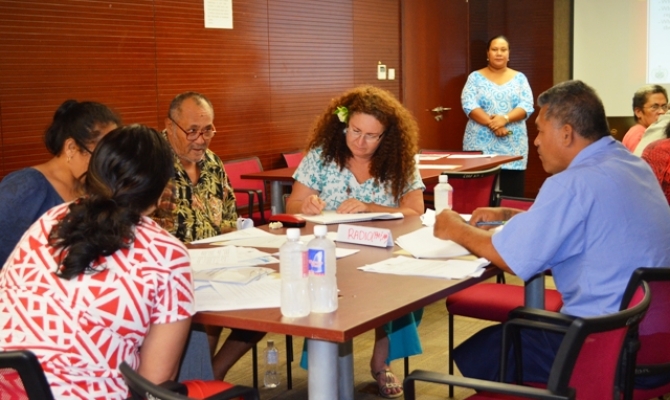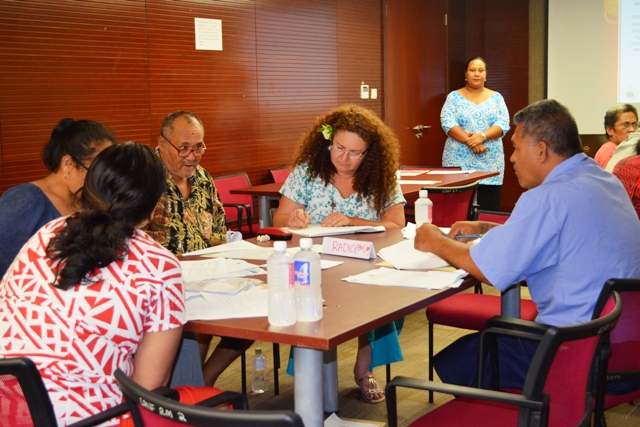
Climate Change Resilience
An earthquake leading to a tsunami in Samoa was the mock 'disaster' at the core of a simulation exercise designed to test the roles of national media.
Held on a wet and windy Monday, the simulation exercise was facilitated by the Samoa Disaster Management Office.
Support was provided through the National Broadcasters Climate and Disaster Resilience Plan Project, which is funded by the Pacific Media Assistance Scheme (PACMAS) and coordinated in partnership with the Secretariat of the Pacific Regional Environment Programme (SPREP) and the Secretariat of the Pacific Community (SPC).
 Radio Broadcsters of Samoa check their responses and actions against the mock earthquake and tsunami
Radio Broadcsters of Samoa check their responses and actions against the mock earthquake and tsunami
The simulation exercise comes at the start of Samoa's National Environment Week and following the completion of Broadcast Climate and Disaster Resilience Plans (BCDRP) for Samoa Quality Broadcasting and Radio 2AP of the Samoa Ministry of Communications and Information Technology.
The mock 'earthquake causing a tsunami' was the prompt for the national media to practice who will be giving directions, what actions were to be taken and how these would be done.
"Through this exercise we were able to dust off our new BCDR plan on my shelf, revisit it with our staff and put this plan into action," said Galumalemana Faiesea Matafeo, CEO of Samoa Quality Broadcasting (SQBL).
"We had our own disaster preparedness drill to see us how long it will take to evacuate the building, taking our most valuable equipment to safety. It proved we could evacuate in minutes to the closest intersection that could take us away from the sea."
The response from the SQBL team was excellent as they put their newly developed Standard Operating Procedures to the test and addressed the mock earthquake and tsunami according to their plan.
Since the workshop to develop the Broadcast Climate and Disaster Resilience Plan for SQBL this year, Galumalemana Faiesea has worked to secure a place for SQBL to broadcast television from a mini studio at the National Disaster Management Office in Tuanaimoto in Samoa. Plans are also under way to obtain a 'Radio in a box' which would also be located in Tuanaimoto.
With two transmission posts, one in Mt Vaea, which serves one half of Upolu and another at Mt Fiamoe, which serves the other half of Upolu, there is confidence that if either of these transmission posts are damaged, the transmission can be switched from one post to the other, allowing for continuous broadcast from SQBL.
"We also have a dedicated response team which is trained to carry out certain duties in times of emergencies and disasters; this includes a maintenance team that checks our equipment daily so that in times of a disaster we know our equipment will be working and we can continue providing a service of information to our communities should there be a disaster."
Both SQBL and Radio 2AP rely on Short Message Service (SMS) from the Samoa Disaster Management Office to alert them to danger but failing that, both have a wireless radio as a back-up. SQBL is also hoping to secure satellite phones to further enhance their communication capacity during times of disaster.
Radio 2AP also has a place to broadcast radio from the National Disaster Management Office at Tuanaimoto but would like to establish a station at its government land at Nu'u where it is hoped another radio mast will be built.
"The current mast we have at Mulinu'u has survived many decades of cyclones, but it is always good to have a second place to transmit from," said Peseta Luelu Setu of Radio 2AP.
"One thing this simulation exercise has highlighted is the importance of planning for preparedness and the role of drills to help strengthen this so we do not have to break transmission during times of emergency. Now that we have our Broadcast Climate and Disaster Resilience Plan, we must keep it fresh in our minds so we can activate it efficiently when needed."
The National Broadcast Climate and Disaster Resilience Plans were completed in July this year under the BCDRP Project for Samoa Quality Broadcasting and Radio 2AP.
The Project has four key outcomes, namely: the development of Broadcast Climate and Disaster Resilience Plans; formation of Standard Operating Procedures; Newsroom training on climate change and disaster management; and a simulation exercise that helps practice and test the new BCDRPs.
The project encompasses national broadcasters in eight Pacific islands - Cook Islands, Kiribati, Palau, Samoa, Solomon Islands, Tonga, Tuvalu and Vanuatu. It is funded by the Pacific Assistance Media Scheme and implemented by the Secretariat of the Pacific Regional Environment Programme (SPREP) in partnership with the Secretariat of the Pacific Community (SPC).
Held on a wet and windy Monday, the simulation exercise was facilitated by the Samoa Disaster Management Office.
Support was provided through the National Broadcasters Climate and Disaster Resilience Plan Project, which is funded by the Pacific Media Assistance Scheme (PACMAS) and coordinated in partnership with the Secretariat of the Pacific Regional Environment Programme (SPREP) and the Secretariat of the Pacific Community (SPC).
 Radio Broadcsters of Samoa check their responses and actions against the mock earthquake and tsunami
Radio Broadcsters of Samoa check their responses and actions against the mock earthquake and tsunamiThe simulation exercise comes at the start of Samoa's National Environment Week and following the completion of Broadcast Climate and Disaster Resilience Plans (BCDRP) for Samoa Quality Broadcasting and Radio 2AP of the Samoa Ministry of Communications and Information Technology.
The mock 'earthquake causing a tsunami' was the prompt for the national media to practice who will be giving directions, what actions were to be taken and how these would be done.
"Through this exercise we were able to dust off our new BCDR plan on my shelf, revisit it with our staff and put this plan into action," said Galumalemana Faiesea Matafeo, CEO of Samoa Quality Broadcasting (SQBL).
"We had our own disaster preparedness drill to see us how long it will take to evacuate the building, taking our most valuable equipment to safety. It proved we could evacuate in minutes to the closest intersection that could take us away from the sea."
The response from the SQBL team was excellent as they put their newly developed Standard Operating Procedures to the test and addressed the mock earthquake and tsunami according to their plan.
Since the workshop to develop the Broadcast Climate and Disaster Resilience Plan for SQBL this year, Galumalemana Faiesea has worked to secure a place for SQBL to broadcast television from a mini studio at the National Disaster Management Office in Tuanaimoto in Samoa. Plans are also under way to obtain a 'Radio in a box' which would also be located in Tuanaimoto.
With two transmission posts, one in Mt Vaea, which serves one half of Upolu and another at Mt Fiamoe, which serves the other half of Upolu, there is confidence that if either of these transmission posts are damaged, the transmission can be switched from one post to the other, allowing for continuous broadcast from SQBL.
"We also have a dedicated response team which is trained to carry out certain duties in times of emergencies and disasters; this includes a maintenance team that checks our equipment daily so that in times of a disaster we know our equipment will be working and we can continue providing a service of information to our communities should there be a disaster."
Both SQBL and Radio 2AP rely on Short Message Service (SMS) from the Samoa Disaster Management Office to alert them to danger but failing that, both have a wireless radio as a back-up. SQBL is also hoping to secure satellite phones to further enhance their communication capacity during times of disaster.
Radio 2AP also has a place to broadcast radio from the National Disaster Management Office at Tuanaimoto but would like to establish a station at its government land at Nu'u where it is hoped another radio mast will be built.
"The current mast we have at Mulinu'u has survived many decades of cyclones, but it is always good to have a second place to transmit from," said Peseta Luelu Setu of Radio 2AP.
"One thing this simulation exercise has highlighted is the importance of planning for preparedness and the role of drills to help strengthen this so we do not have to break transmission during times of emergency. Now that we have our Broadcast Climate and Disaster Resilience Plan, we must keep it fresh in our minds so we can activate it efficiently when needed."
The National Broadcast Climate and Disaster Resilience Plans were completed in July this year under the BCDRP Project for Samoa Quality Broadcasting and Radio 2AP.
The Project has four key outcomes, namely: the development of Broadcast Climate and Disaster Resilience Plans; formation of Standard Operating Procedures; Newsroom training on climate change and disaster management; and a simulation exercise that helps practice and test the new BCDRPs.
The project encompasses national broadcasters in eight Pacific islands - Cook Islands, Kiribati, Palau, Samoa, Solomon Islands, Tonga, Tuvalu and Vanuatu. It is funded by the Pacific Assistance Media Scheme and implemented by the Secretariat of the Pacific Regional Environment Programme (SPREP) in partnership with the Secretariat of the Pacific Community (SPC).